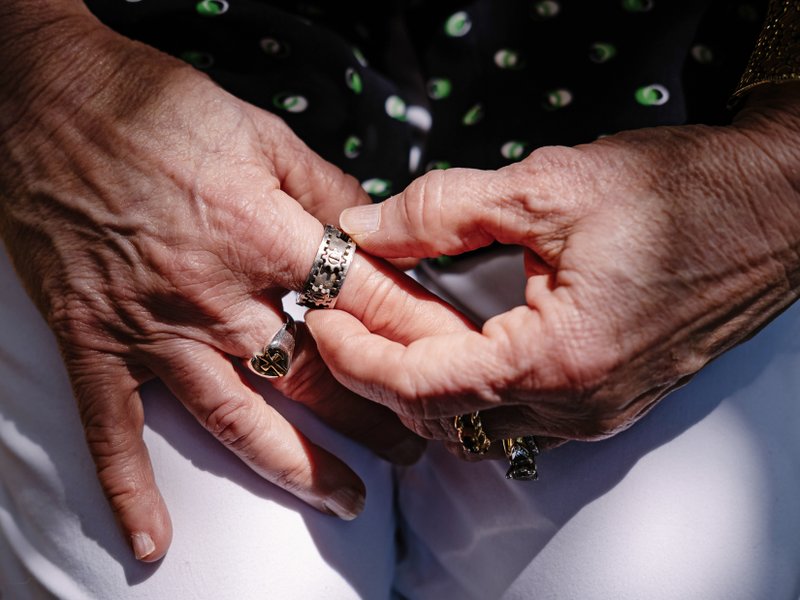When Deborah Huffman went for her annual physical a few years ago, she saw a new doctor who handed her a paper gown, instructing her to leave it open in the back. The doctor returned a few minutes later to find Huffman in the gown, sobbing.
What was wrong?
"I pick at my skin," Huffman, who is now 65, remembers saying. The doctor peered at Huffman's back, which was dappled with scabs.
It was the first time that Huffman, a retired administrative assistant and former teacher who lives in Dripping Springs, Texas, had told anyone about the habitual behavior that, since childhood, had made her feel ashamed.
She had long taken pains to conceal the damaged skin on her back, hiding it even from her former husband throughout their 21-year marriage.
Huffman had assumed that the skin-picking behavior was unique to her. It never occurred to her to seek treatment.
In fact, it's relatively common. So, too, are a family of related habitual behaviors that include hair pulling, nail biting and cheek biting, among others. While there's no easy fix, they can typically be treated in a psychotherapy setting by a clinician trained in habit-reversal therapy and other behavioral therapy methods.
Nearly everyone picks at the occasional scab or plucks a stray hair now and then. But mental health professionals make a distinction between those normal grooming acts and a habit that an individual is unable to curb despite attempts to do so, or which causes distress. Habits that meet these criteria are known collectively as body-focused repetitive behaviors. Some patients engage in more than one.
Habitual skin picking is formally called excoriation disorder (and also known as dermatillomania). It affects roughly 1.4% of the population, according to the fifth edition of the Diagnostic and Statistical Manual of Mental Disorders (DSM-V). (Some studies put the rate higher.) Hair pulling, or trichotillomania, occurs in about 0.5% to 2% of people, according to the same manual. The behaviors are classified in the chapter covering obsessive-compulsive and related disorders. This edition, published in 2013, was the first in which the American Psychiatric Association included detailed information about skin picking.
Because patients often work to hide evidence of the disorders, researchers and clinicians suspect that those rates represent an under-reporting. But even at these levels, they add up to a more prevalent disorder than some others that tend to be more familiar, such as anorexia nervosa, which affects only 0.4% of young women, according to the DSM-V.
MOOD DISORDERS
These repetitive behaviors typically emerge around the onset of puberty, although they can begin earlier, and are more common in females. They tend to occur along with mood disorders such as anxiety and depression, or with obsessive-compulsive disorder. Patients report feeling an urge to pick or pull, followed by a physical sensation of relief or gratification while engaging in the behavior itself.
At their most severe, the conditions can put patients at medical risk, said Dr. Katharine A. Phillips, professor of psychiatry at Weill Cornell Medical College. For skin pickers, she said, that could mean serious infection or blood-vessel injury. Some hair pullers ingest the hairs they pluck; accumulation of hair in the gastrointestinal tract could cause digestive problems requiring surgery.
For many people with body-focused repetitive behaviors, though, the effects are cosmetic, and the consequences emotional and social.
Mindy Mitchell, an insurance agent who lives in Shelbyville, Tenn., noticed in August 2017 that her elder daughter, Alyssa, who was 9, had begun to pull hair from her scalp. Within six months, Alyssa was bald except for a strip along her crown.
Mitchell, who is 36, was alarmed but unsure of what to do. Kids at school began to tease Alyssa for her baldness, calling her names like "cancer girl."
She took Alyssa to be fitted for a wig.
GROUP SUPPORT
When Mitchell eventually searched online, she came across the nonprofit TLC Foundation for Body-Focused Repetitive Behaviors, a patient-advocacy organization.
The group maintains an online database of clinicians with relevant experience, and convenes an annual conference for patients, family members, clinicians and researchers. Mitchell and Alyssa were among more than 440 attendees at this year's gathering in Chantilly, Va., in May. Alyssa befriended other children. Mitchell left with recommendations for treatment close to home.
As for Huffman, the doctor recommended she see a psychologist. She found a local therapist skilled in habit-reversal and cognitive-behavioral techniques. After going to weekly sessions for a year, she learned some strategies for resisting the urge to pick, such as noticing when the urge strikes and having fidget toys at the ready. She's picking much less now, she said, but still feels self-conscious about scarring.
The therapist also told Huffman about the TLC conference, and she attended in 2017. There, Huffman saw a hotel ballroom full of people who were working to address behaviors similar to hers. She was moved to tears.
When she got home, Huffman approached her husband.
"I have something I want to tell you," she remembers saying. "I want you to see my back."
Style on 09/16/2019

